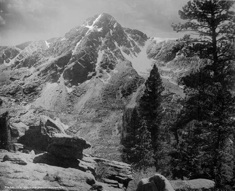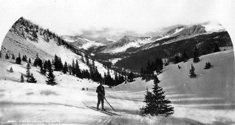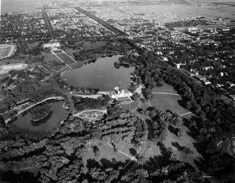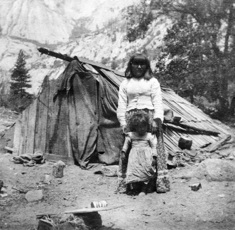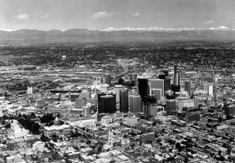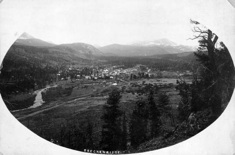Teaching the Article
Exercise 2
All of the materials associated with this exercise are available for download.
What Is Wilderness?
What is wilderness? There is no straightforward answer to this question. This exercise explores how we define wilderness and how those definitions have been shaped by history.
Step 1. To begin this exercise, show these seven images and ask the students (preferably in small groups) to rank them from most to least representative of wilderness. How did the students rank the images? Urge the students to offer reasons for their rankings. On what basis did they make their judgments? Can wilderness include people? Can wilderness include historical evidence of people who once inhabited the landscape? Which human activities are permissible in wilderness (human habitation, hiking, biking, hunting, logging, motor vehicles, etc.)? How might the students have defined wilderness differently if they lived in the nineteenth century? What if they lived in a developing country? Ask students to draw a line separating the landscapes that deserve to be protected as wilderness from those that do not. Where did they draw that line? (If you would like to assemble your own set of images, a great resource for doing so is the wilderness.net photo database.)
Step 2. Once students have drawn a line dividing wilderness from non-wilderness, challenge them to translate that distinction into words. Ask each small group to write three or four sentences that 1) explain the purpose of protecting wilderness and 2) define what land deserves protection as wilderness.
Step 3. Defining wilderness was a task Congress took seriously in the 1950s and 1960s. Congress spent eight years debating the bill that would become the Wilderness Act of 1964 at the behest of wilderness groups concerned about the future of the nation’s public lands. Present the students with the definition of wilderness found in section 2(c) of the Wilderness Act. How does this definition compare with the students’ definition? Why might Congress have defined wilderness differently in 1964 than students do today?
The Wilderness Act defined wilderness on federal lands, created the National Wilderness Preservation System, and set in motion efforts to protect federal wilderness areas that continue to this day. The leader of those efforts was Howard Zahniser, who was the chief author of the Wilderness Act and executive director of the Wilderness Society, a leading environmental group. Since 1964, Congress has expanded the wilderness system from 54 areas totaling 9.1 million acres largely in the West to 756 areas totaling 109.5 million acres nationwide. For a graphic representation of this growth, see this interactive map of the wilderness system.
Images
- Mountain Wilderness
- Indians-Yosemite
- Mountain Recreation
- Pastoral Scene
- Suburban Park
- City Center
- Mountain Road
Document
Web Sites
- Wilderness.net Photo Database — http://www.wilderness.net/index.cfm?fuse=NWPS&sec=simplesearch
- Wilderness.net Map of the National Wilderness Preservation System http://www.wilderness.net/index.cfm?fuse=NWPS
For Further Reading
The meaning and significance of wilderness in American history has been a subject of debate among scholars, especially in the last fifteen years. William Cronon, in his essay “The Trouble with Wilderness,” argues that America’s fascination with wilderness is a product of its frontier mythology and its fascination with the sublime. He suggests that the preoccupation with wilderness might even serve to distract environmentalists from more pressing environmental issues. Carolyn Merchant, in her essay “Shades of Darkness,” argues that by defining wilderness as places excluding people, the history of Native Americans and others who once occupied the nation’s wild lands has been erased. The Wilderness Act may have given wilderness a legal definition, but that has only precipitated a continuing debate over the significance of wilderness in American history.
- William Cronon, “The Trouble with Wilderness; or, Getting Back to the Wrong Nature,” in Uncommon Ground: Rethinking the Human Place in Nature, ed. William Cronon (New York, 1995), 69–90, http://www.williamcronon.net/writing/Trouble_with_Wilderness_Main.html.
- Carolyn Merchant, “Shades of Darkness: Race and Environmental History,” Environmental History, 8 (no. 3, 2003), 380–88.
For an excellent overview of different perspectives and debate on the value of wilderness across disciplines and time, see these two volumes:
- J. Baird Callicott and Michael P. Nelson, eds., The Great New Wilderness Debate: An Expansive Collection of Writings Defining Wilderness from John Muir to Gary Snyder (Athens, Ga., 1998).
- J. Baird Callicott and Michael P. Nelson, eds., The Wilderness Debate Rages On: Continuing the Great New Wilderness Debate (Athens, Ga., 2008).
For an introduction to Howard Zahniser and the Wilderness Society, the formative debates over wilderness in the 1930s, and the sweep of wilderness history, respectively, see these four books:
- Mark Harvey, Wilderness Forever: Howard Zahniser and the Path to the Wilderness Act (Seattle, 2005).
- Paul Sutter, Driven Wild: How the Fight against Automobiles Launched the Modern Wilderness Movement (Seattle, 2002).
- Roderick Nash, Wilderness and the American Mind (New Haven, 2001).
- Doug Scott, The Enduring Wilderness: Protecting Our Natural Heritage through the Wilderness Act (Boulder, 2004)


